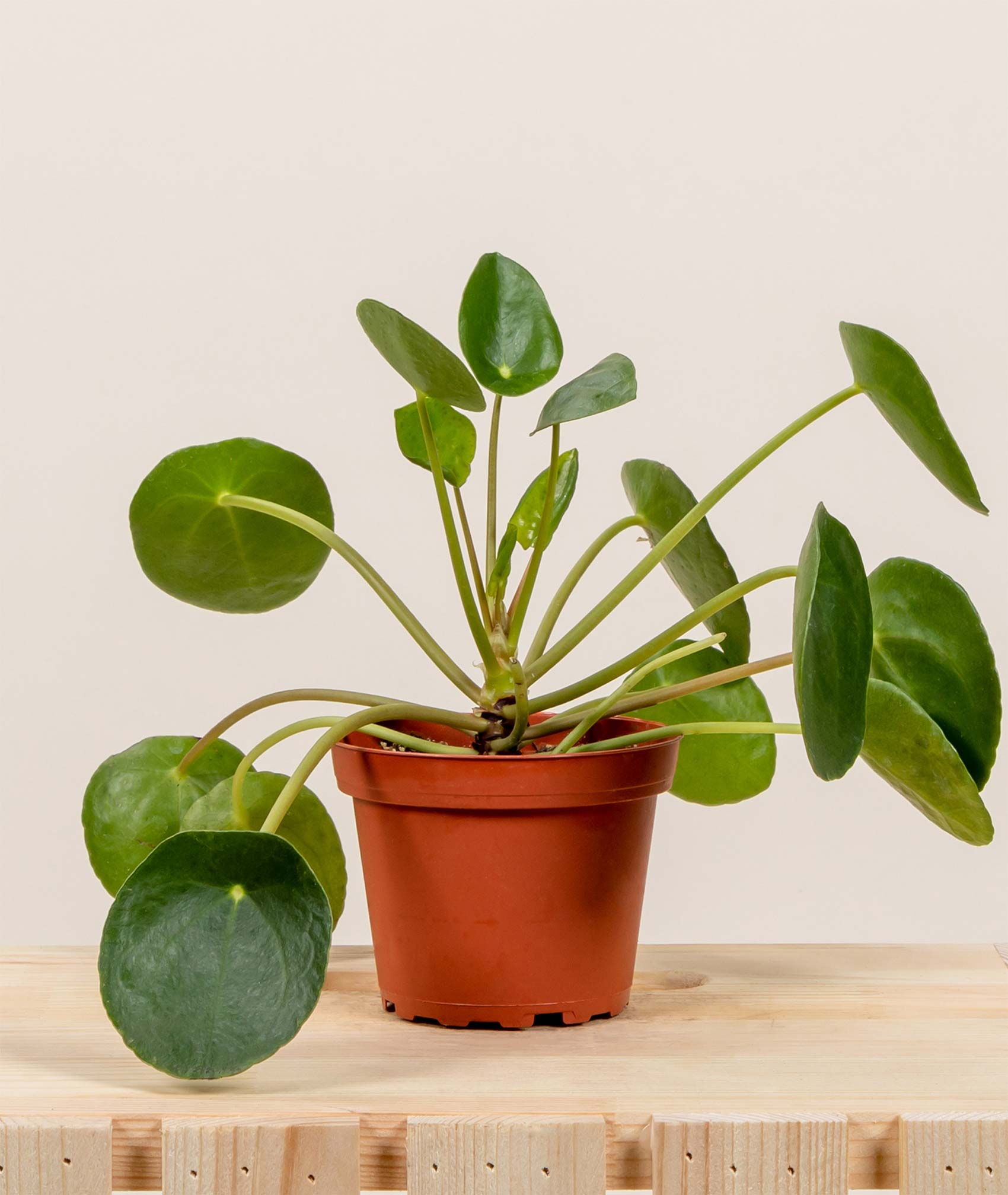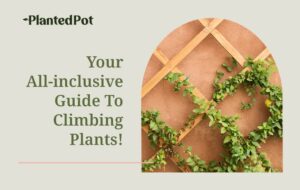
Pilea Peperomioides
$23
 Plastic grow pots come in different colors, you may receive a black or rust colored pot.
Plastic grow pots come in different colors, you may receive a black or rust colored pot.
Also known as the Chinese Money Plant, the Pilea Peperomioides is believed to bring good fortune to its owners. The charming, circular-shaped leaves bring personality into any space you put them in. Many plants hate the cold, but this beauty may actually have an increased chance of flowering if exposed to cool temperatures now and then. To get the most out of your Pilea, rotate it once every few days. This will allow the leaves to grow evenly in all directions. Coming from China’s Yunnan province, Pilea Peperomioides has become synonymous with prosperity, good luck, and stunning decor!
Medium to bright indirect light
Water before soil starts to dry
65° – 75°F
Related Products
Pilea Peperomioides
Are you or someone you know feeling down on their luck? Then, kickstart your change in fortune with the Pilea Peperomioides, also known as the Chinese Money Plant. The Pilea Peperomioides is known for bringing money and luck to its owner, but it makes an attention-grabbing houseplant as well!
The Chinese Money Plant doubles as a great gift for friends or family members and a plant that brings luck and prosperity to the household. This plant also looks amazing as a centerpiece on a kitchen table or at an office desk. Let’s take a look at why you should get a Pilea Peperomioides for your home, basic care tips, and more fun facts about this beautiful plant!
What is a Pilea Peperomioides Plant?
The Pilea Peperomioides is a fast-growing, flowering plant originating from the base of the Himalayan Mountains of the Sichuan and Yunnan provinces in Southern China. This region is often recognized as having the most biodiversity of plants and animals in the entire country of China.
The Pilea Peperomioides’ rise to one of the most popular houseplants in the world started when a Norwegian missionary Agnar Espegren snuck a propagated Pilea Peperomioides out of the Yunnan province and grew the plant for himself. He then gave away propagated plants to his friends, and the plant began to slowly spread across Europe.
This flowering perennial plant is a member of the genus Pilea, part of the Urticaceae plant family. This plant has a couple of nicknames such as:
- Chinese Money Plant
- Mother Plant
- UFO Plant
- Friendship Plant
- Missionary Plant
- Pancake Plant
- Coin Plant
The long stem of the Chinese Money Plant is upright and usually or dark green or slightly brownish and is connected to the root system. At the end of the stem are slightly smaller petioles attached at the center to a coin-shaped leaf. The Pilea’s leaves are bright to slightly darkish green in color.
Plant Size
If you are worried about the Chinese Money plant taking up too much space inside your home or on a desk, there’s no need to worry! The Pilea Peperomioides can grow as tall as 12 inches or slightly more when it fully matures. Its width is usually about the same size as its height.
The coin-shaped leaves are about 4 inches in diameter. Since this plant does not take up space, you might want to own more than one!
Light Requirements
Wherever you end up placing your Chinese Money Plant, make sure it is somewhere with plenty of bright indirect light. Keep it out of direct sunlight, or the leaves might get sunburn.
Light from the sun gives plants energy to make food through photosynthesis. Plants tend to grow in the direction of the sunlight, so it’s important to rotate your plant every two weeks, so it grows more symmetrical.
Watering
Watering your plant is another part of photosynthesis for your Pilea Peperomioides plant. This plant can handle being watered weekly. Just make sure to allow the soil to dry out between waterings.
Avoid overwatering by putting your Pilea in a pot with drainage holes and well-draining soil. Your lovely plant is susceptible to fungal infections such as root rot when too much water is trapped in the soil.
The leaves on the Chinese Money plant might start to wither if they do not receive enough water. It helps to keep a record each time you water your plant to visually see how you can make watering adjustments and, more importantly, stay consistent.
Temperature & Humidity
One of the main reasons this plant is a popular indoor plant is that it can handle normal room humidity and temperature. The ideal temperature range for the Pilea Peperomioides plant is between 55-85°F.
You can even increase the moisture around the air by misting your plant’s leaves. Your plant may die if left in extreme temperatures for an extended amount of time. Another great solution is putting a humidifier in the room or place a bed of wet rocks below the pot.

Why Choose a Pilea Peperomioides Plant for Your Home?
Besides the fact that it is regarded as good fortune, there are even more reasons to have a Pilea Peperomioides plant under your care. Whether your place is in your home or you keep it at work, this plant will be a constant supply of good vibes!
Here are some of the reasons why you should own this plan:
- Eases Stress: When people think of happy places, some of them imagine a setting involving nature. Since people can’t leave to a forest in the middle of the day, having a plant nearby helps fill that void. Surrounding yourself with plants may lower your nervousness.
- Promotes Focus: Do you catch yourself getting distracted easily? You may be able to focus better during work or in class if you are near a couple of plants.
- Enhances Productivity: It is hard to be motivated when you are working in a dull setting. A room decorated with plants will get the creative juices in your head going.
- Boosts Healing: Plants help people feel better. When people feel better mentally, they might physically feel better too.
- Purifies Air: The airspace indoors carries more pollutants than outside. Help make the air around you easier to breathe by owning a few air-purifying plants.
- Increases Humidity: If you feel like the air inside your home is a little dry, owning houseplants helps increase the moisture in the air.
- Promotes Self-Accomplishment: It feels amazing when you can see the fruits of your labor. Since the Pilea Peperomioides is an easy maintenance plant, you feel accomplished when you see its growth.
Are Pilea Peperomioides Plants Good Indoors & Outdoors?
Plants are known to grow all around the world. When it comes to the Pilea Peperomioides plant, they can grow both indoors or outdoors. Which one you decide depends on your location, available resources, and gardening experience.
Indoors
This plant became a global icon thanks to its popularity as a house plant. The Pilea should be kept near an indirect light source like a window. You can ensure your plant will remain healthy by making sure to water it at least once a week. Also, be sure to re-pot periodically (once every year) so you can replenish the roots with fresh soil and nutrients.
Outdoors
Too much sun exposure and our Pilea will wither and eventually die. Therefore, it is best to mimic its natural habitat and keep this plant in the shade to still receive light. It can make a great decorative piece if placed in a terracotta container. Just be sure it has drainage holes so water can escape!
Are Pilea Peperomioides Plants Pet and Children Friendly?
The Pilea Peperomioides plant is not just a horticultural beauty but also very pet-friendly. It is non-toxic to children, people, and common household pets.
Some other houseplants are slightly toxic and can cause unwanted side effects. It is best to keep this plant out of paw’s or small hand’s reach. The Pilea, or UFO plant, can be kept as a hanging plant where it is more difficult for your kids, cats, or dogs to grab.
Pilea Peperomioides Plant Family Relatives
The Pilea genus is the largest group in the Urticaceae family. This plant genus can be found naturally in many different parts of the world. Get to know of the Chinese Money Plant’s relatives.
- Pilea Aluminum Plant: If you want a bold but easy to care plant, the Pilea Aluminum plant fulfills that role. The variegated leaves are green with a splash of silver on them.
- Moon Valley Pilea: Similiar in size to the Mother plant, the Moon Valley Pilea has unique leaves that appear to be dimpled. The deeply textured leaves are green, with some having red under shades.
- Pilea Depressa (Baby Tears): This trailing plant is admired by the tiny but dense bright green foliage. When examined closer, the leaves appear with ruffled edges.
Plants That Are Similar to the Pilea Peperomioides
There are plenty of plants that may not be in the Pilea genus but still look great when paired up next to your Pilea Peperomioides. For example, if you appreciate the coin-shaped leaves, you might enjoy one of the following plants.
- Marsh Pennywort: This tiny plant has green umbrella-shaped leaves. It enjoys moist soil but can also be grown as an aquatic plant. It is also edible and well-toleration for human consumption.
- Navalwort: This succulent plant is known for its naval-like green leaves that look like belly buttons. It is found growing out of cliffs or rock crevices and is used for medicinal purposes.
Final Thoughts – Pilea Peperomioides Plant
Plants make great botanical ornaments and can improve a person’s wellness. When it comes to bringing good luck to its owners, no plant can compare to the Pilea Peperomioides. This plant is a must-have whether you are an experienced gardener or a first-time plant owner. For other amazing plants, check out PlantedPot!





Reviews
There are no reviews yet.